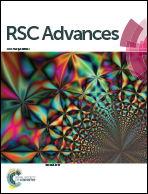Improved amplified spontaneous emission of organic gain media with metallic electrodes by introducing a low-loss solution-processed organic interfacial layer†
Abstract
The metallic effects of Ag, Al, Cu, and Au electrodes on the amplified spontaneous emission (ASE) actions of dioctyl substituted polyfluorene (PFO) have been investigated in detail. The results showed that the optical gain properties of PFO were seriously quenched by thin metallic electrodes. According to the results of photoluminescence (PL) spectra, ASE characterizations, PL decay, and PL quantum yield (PLQY), quenching effects of thin electrodes were found to follow the trend in the order of Ag < Al < Cu < Au. To restrict the quenching effects, water/alcohol-soluble cellulose acetate (CA) with relatively low optical losses was introduced as the interfacial layer between the electrode layer and the gain layer by spin-coating, leading to enhanced ASE restoration and threshold reduction. Consequently, by optimizing the thickness of CA layer, ASE restoration and even 39-fold, 40-fold, 6.3-fold, and 10-fold threshold reductions from 212 μJ cm−2, 230 μJ cm−2, 145 μJ cm−2, 212 μJ cm−2 to 5.4 μJ cm−2, 6.6 μJ cm−2, 23 μJ cm−2, 21 μJ cm−2 were obtained for Ag-based, Al-based, Cu-based, and Au-based devices, respectively.


 Please wait while we load your content...
Please wait while we load your content...